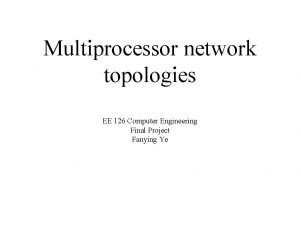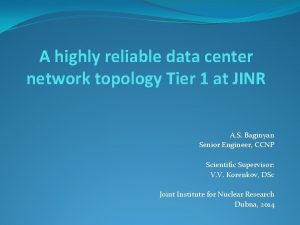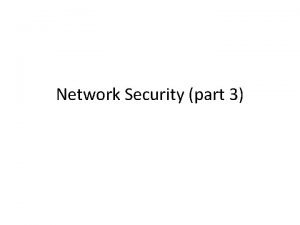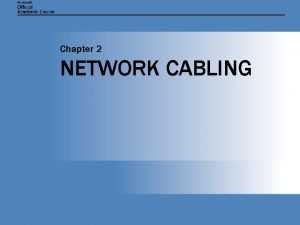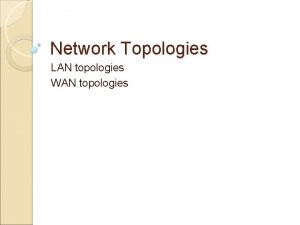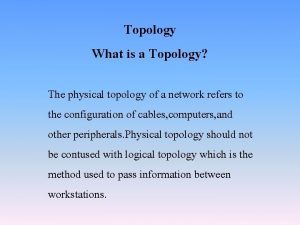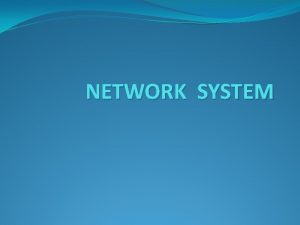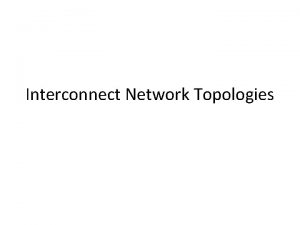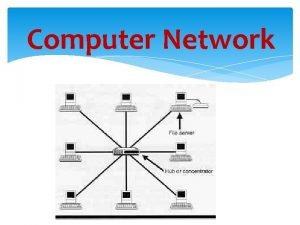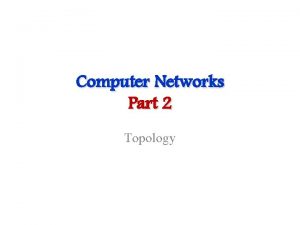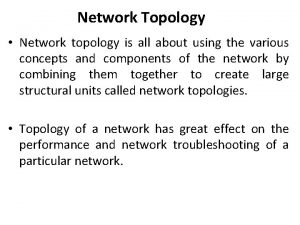Network Topologies LECTURE1 1 Network Topology is the













- Slides: 13

Network Topologies LECTURE-1. 1

Network Topology is the schematic description of a network arrangement, connecting various nodes (sender and receiver) through lines of connection. Types of Network Topology 1. Mesh Topology 2. Ring Topology 3. Star Topology 4. Bus Topology 5. Tree Topology 6. Hybrid Topology

Mesh Topology(1/2) • It is a point to point connection to other devices and all network nodes are connected to each other as well as all devices has equal status. • For n devices(nodes), mesh topology has n(n-1)/2 number of connecting links. • Mesh topology exists in WAN mostly.

Mesh Topology(2/2) Advantages of Mesh Topology 1. 2. 3. 4. Each connection carry its own data load. It is robust. Fault is diagnosed easily. Provides security and privacy. Installation and configuration is difficult. Cabling cost is more. Bulk wiring is required.

Star Topology In star topology, all devices are controlled by a central device, called HUB. These all devices are connected to HUB. Advantages of Star Topology 1. 2. 3. 4. 5. Fast performance with few nodes and low network traffic. Hub can be upgraded easily. Easy to troubleshoot. Easy to setup and modify. Only that node is affected which has failed, rest of the nodes can work smoothly. Disadvantages of Star Topology 1. Cost of installation is high. 2. Expensive to use. 3. If the hub fails then the whole network is stopped because all the nodes depend on the hub. 4. Performance is based on the hub that is it depends on its capacity

Ring Topology(1/2) It is called ring topology because it forms a ring as each computer is connected to another computer, with the last one connected to the first. Exactly two neighbors for each device. It transfer data in unidirectional to avoid collision. To make it bidirectional we use a technique called Token Ring Technique. Advantages of Ring Topology Disadvantages of Ring Topology 1. Transmitting network is not affected by high traffic or by adding more nodes, as only the nodes having tokens can transmit data. 2. Cheap to install and expand 1. Troubleshooting is difficult in ring topology. 2. Adding or deleting the computers disturbs the network activity. 3. Failure of one computer disturbs the whole network.

Ring Topology(2/2) 1. In this we replace connecter with repeater to make signals strong. 2. Repeater : It deals digital signals 3. Amplifier: It deals analogue signals.

Bus Topology(1/2) Bus topology is a network type in which every computer and network device is connected to single cable. When it has exactly two endpoints, then it is called Linear Bus topology

Bus Topology(2/2) Advantages of Bus Topology 1. It is cost effective. 2. Cable required is least compared to other network topology. 3. Used in small networks. 4. It is easy to understand. 5. Easy to expand joining two cables together. 1. Cables fails then whole network fails. 2. If network traffic is heavy or nodes are more the performance of the network decreases. 3. Cable has a limited length. 4. It is slower than the ring topology.

Tree Topology(1/2) It has a root node and all other nodes are connected to it forming a hierarchy. It is also called hierarchical topology. It should at least have three levels to the hierarchy.

Tree Topology(2/2) Advantages of Tree Topology 1. 2. 3. 4. Extension of bus and star topologies. Expansion of nodes is possible and easy. Easily managed and maintained. Error detection is easily done. Advantages of Tree Topology 1. Heavily cabled. 2. Costly. 3. If more nodes are added maintenance is difficult. 4. Central hub fails, network fails.

Hybrid Topology(1/2) It is a mixture of two or more topologies. For example , in an office, in one department ring topology is used and in other department star topology is used, connecting these topologies will result in Hybrid Topology (ring topology and star topology).

Hybrid Topology(2/2) Advantages of Hybrid Topology 1. Reliable as Error detecting and trouble shooting is easy. 2. Effective. 3. Scalable as size can be increased easily. 4. Flexible. 1. Complex in design. 2. Costly.
 Network topologies and layout
Network topologies and layout Ee 126
Ee 126 Physical topologies
Physical topologies Whats my ip
Whats my ip Highly reliable topology
Highly reliable topology What is topology in computer
What is topology in computer Network topology ppt presentation free download
Network topology ppt presentation free download Three-tier network topologies
Three-tier network topologies Three basic network topologies
Three basic network topologies Network security topologies
Network security topologies Cabling
Cabling Bus, ring and star topologies mostly used in the
Bus, ring and star topologies mostly used in the Wlan lan
Wlan lan Clos topologies
Clos topologies

